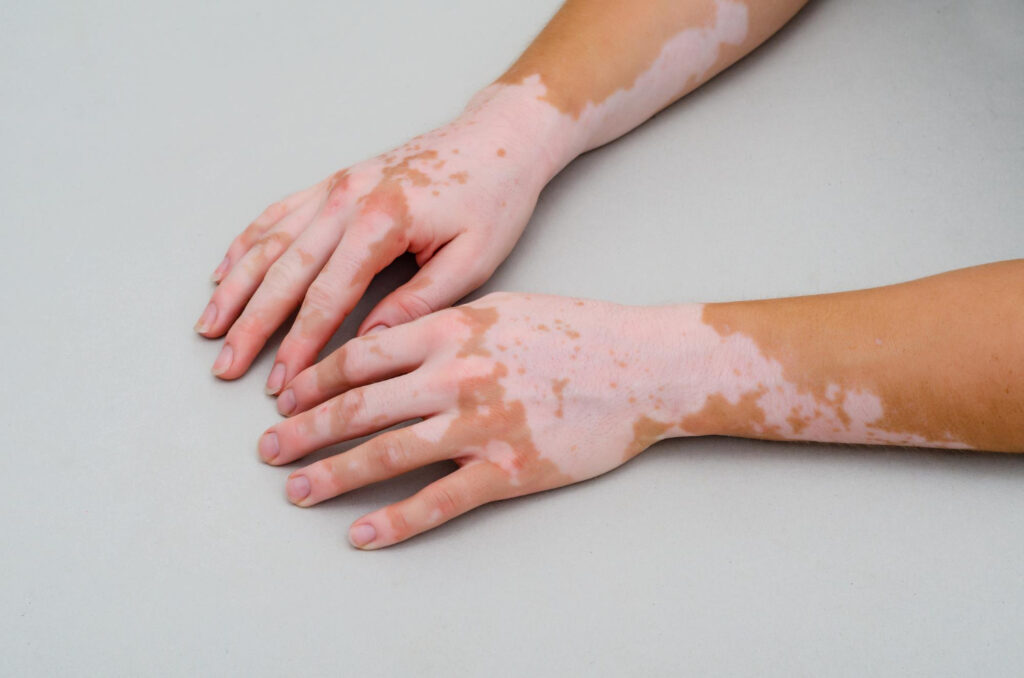Key Takeaways
- Vitiligo happens when pigment-producing cells (melanocytes) stop working, causing white patches on the skin.
- It’s not contagious, painful, or life-threatening, but it can affect self-confidence and emotional well-being.
- The exact cause of vitiligo isn’t fully known, though autoimmune, genetic, and environmental factors play roles.
- Early medical advice helps in managing symptoms effectively.
What Exactly Is Vitiligo?
Vitiligo is a long-term skin condition that causes certain areas to lose their natural colour. This happens when melanocytes, the cells that produce skin pigment, are damaged or stop functioning. These white patches can show up anywhere – on the face, hands, arms, feet, scalp, or even inside the mouth.
Though vitiligo can affect anyone, it’s often more noticeable on darker skin. The good news: it’s not infectious and has nothing to do with hygiene.
Why Do These White Patches Appear?
Doctors haven’t pinpointed one exact cause, but several factors may contribute:
- Autoimmune reaction: The immune system mistakenly targets pigment cells.
- Genetics: Having relatives with vitiligo or autoimmune conditions increases risk.
- Environmental triggers: Sunburn, stress, or certain chemicals can worsen symptoms.
- Nerve interactions: Changes in nerve signals may impact pigment cells.
Can Vitiligo Spread or Worsen Over Time?
Yes, for some people, vitiligo can spread gradually over time, whereas in others, new patches appear quickly. However, the pattern and rate of progression differ for every individual. Sometimes, patches can also remain stable for extended periods.
What Are the Possible Ways to Manage Vitiligo?
While there is no permanent cure, a variety of treatments may help to minimise the appearance or spread of white spots. Management options should be discussed with a qualified medical expert and may include:
- Topical therapies prescribed by a doctor to help restore skin colour.
- Phototherapy, a type of treatment that involves controlled light exposure.
- Camouflage products such as skin-matching creams or make-up to provide aesthetic coverage.
- Lifestyle management including sun protection and mental health support.
It’s important to remember that treatment outcomes are unique to each person, and visible progress may take time.
FAQs About Vitiligo
1. Is vitiligo a contagious disease?
No, vitiligo is not communicable. It cannot be transmitted through touch, sharing meals, or physical contact.
2. Does stress cause vitiligo?
Stress does not directly cause vitiligo, although it can serve as a trigger in genetically predisposed individuals. Managing stress can help you avoid flare-ups.
3. Can vitiligo affect hair or scalp?
Yes, vitiligo can result in white or grey hair on the scalp, eyelashes, eyebrows, or beard if pigment loss occurs in those areas.
4. Will my skin colour return completely?
Some areas may regain colour partially or completely after treatment, while others may not. Each case is unique, and regular follow-up with a medical professional is essential.
Take the First Step Towards Understanding Your Skin
If you notice white or light patches on your skin, don’t wait – consult a dermatologist early. The sooner you act, the better your chances of managing it effectively.
At ANG Skin & Hair Clinic, our medical professionals provide advice and guidance to help you understand and manage conditions like vitiligo. Every individual’s skin tells a different story, and recognising the cause is the first step towards restoring confidence in your skin.
Schedule your consultation with ANG Skin & Hair Clinic today to learn more about vitiligo management and care.



